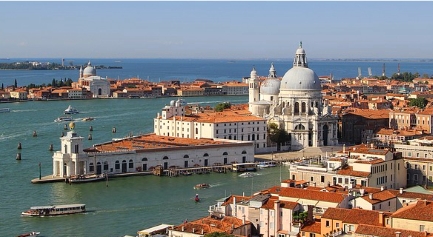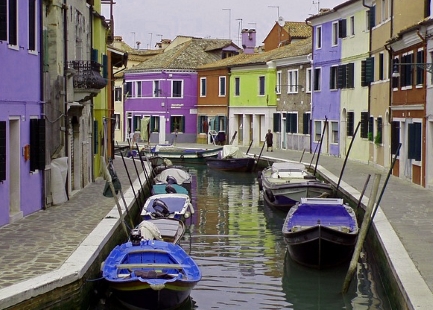|
Venice Overview |
||||||||
Insider tip: Travel comfortably without queues, buy tickets online beforehand:
|
The city of Venice lies on the northern Adriatic coast of Italy. One part of the city is on islands, another part on the mainland. The main island is the actual city of Venice.
This island is connected to the mainland by a bridge almost four kilometres long. The bridge for the railway was completed in 1846, and the car bridge was built between 1931 and 1933. The two bridges are so close to each other that it looks like one bridge. Today the railway bridge to Venice has four tracks, the motorway bridge four lanes. The new tram has been using this bridge now for several years. The bridge bears the beautiful name Ponte della Liberta (Freedom Bridge)..
Today, Venice has a total population of 270,000 and an area of 414 square kilometres. About 60,000 live on the actual island Venice (Centro Storico) and 30,000 on other islands. The majority of the population of Venice now lives on the mainland, unlike in the past. Map of Venice with mainland and islands
Brief overview of means of transport The main airport is on the mainland, just 10 km north of Venice (see Marco Polo Airport). Another smaller airport is Venice Treviso. It is often used by cheap airlines like Ryanair. The third airport on the island of Lido near Venice is the oldest airport in the Venice region. Today the private planes of the rich, hobby pilots and so on land here. Normal passenger flights to Lido no longer exist (info from 2018). Venice is easy to reach by train. Virtually all trains to Venice first stop on the mainland at Mestre Central Station. Then they continue over the bridge to the main island and end at Santa Lucia sack train station. Venice is one of the very few large cities in Europe where more people travel by train than by car. The car is quite useless on the main island of Venice due to the lack of roads, parking is expensive. More information about public transportation in Venice can be found on this page. Division of Venice into districts and urban districts The most important part of the city is the main island of Venice, also known as Centro Storico (Historic Centre). It is the actual Venice with almost all the top sights of Venice. The number of inhabitants on the island Centro Storico decreased in the last years, the number of tourists, restaurants and hotels increased. Many people also moved to the mainland because of the high prices and the more and more frequent floods. The resident population on the island has a high average age, especially younger people do not want to live directly in Venice anymore. They prefer to commute from the mainland to the main island Centro Storico. A lot of people work in tourism on the old town island. Currently, the actual island Venice has only 60,000 inhabitants and the population continues to decrease. The old town of Venice is big. The island Centro Storico has an area of about 5 kmē. Some parts of the city are more than an hour's walk away from each other. The Centro Storico is divided into six districts. These are San Marco, Cannaregio, San Polo, Santa Croce, Dorsodur and Castello. In the individual districts, the addresses are not indicated primarily with street names. The houses are simply numbered. However, the street name is often given in addition. In Italian, the districts of the main island of Venice are called Sestieri (singular: Sestiere). The majority of the inhabitants of Venice now live in the mainland districts. Mestre and Marghera, for example, are well known. Some islands of Venice Beside the above mentioned island Centro Storico, at least 100 more islands belong to the city of Venice. One famous and large island is Murano. It has almost 5.000 inhabitants and is often visited by tourists during day trips with one of the many ferries from Venice (water buses). The glass art and glassblowers of Murano are world famous. This is why the island is also called the island of glass.
The densely populated island of Burano with almost 3000 permanent residents is also popular. This island also lives from tourism. Burano is known for its lace knitting (Burano lace). Not much less famous are the colourful buildings of Burano (see picture). Another big island is Lido (official name Lido di Venezia). The island of Lido is 11 km long, but very narrow. In total Lido has only 4 kmē. With these figures you can calculate that Lido is on average only about 360 meters wide. South of Lido is the elongated island of Pellestrina with about 4,500 inhabitants. Pellestrina is very popular with tourists who travel by bike. The inhabitants live mainly from tourism and shellfishing. But on Pellestrina there are far fewer tourists than for example on the old town island Centro Storico. To the north lies the lagoon island of Sant Erasmo. Even fewer tourists come here. On Sant Erasmo many vegetables were cultivated. Famous are the artichokes and the asparagus. You can buy the vegetables for example at the market of Rialto in the centre of the old town. Sant Erasmo is with an area of more than 3 kmē the biggest of the outer islands of Venice (lagoon islands). Many visitors from abroad visit the interesting island of San Michele between the old town and Murano. On San Michele there is above all a big cemetery worth seeing. That's why the island is called "cemetery island". There are over 100 other islands. Many are inhabited. Some are only accessible by ferry, others are connected by bridges with other islands of Venice or with the mainland.
Our city map (sights and much more)
|
|
||||||

